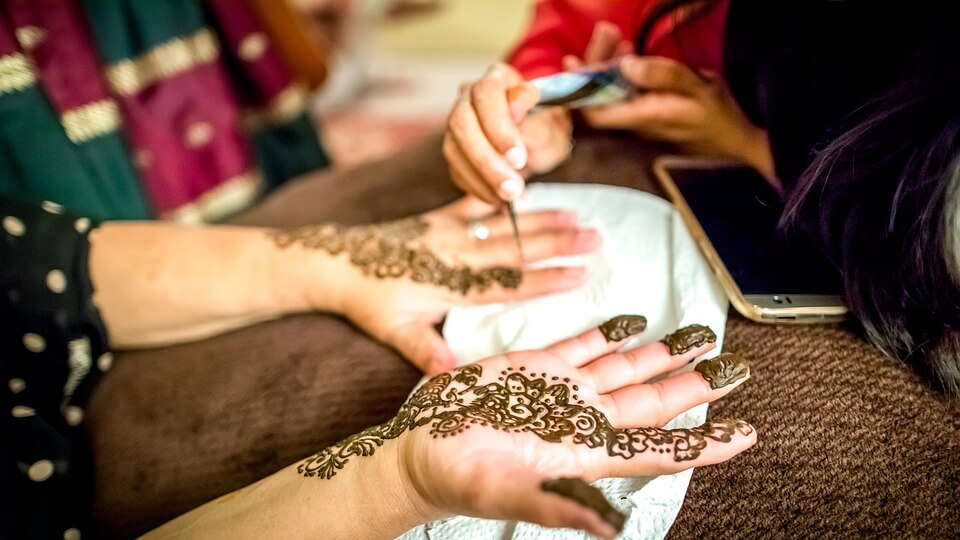As Wedding Know How editors, we write about things that we love and we think you'll like too. We have affiliate partnerships and sponsorship and may generate some revenue from these at no cost to you.
Marriage is a religious as well as social event in India, with different communities having their own unique traditions and customs. The most common aspects of all marriages are vows to be together no matter what, along with prayers, a grand feast and a get together with relatives and friends enjoying music and dancing to their hearts’ content! After all, marriage is not only the sacred union of the bride and the groom but a union of their two families as well.
In the past, Indian families generally took a whole month off for a wedding in the family. They spent this month sitting, chatting together and cooking meals together. However, this has changed over the years and now a typical Indian wedding lasts anywhere from 3 days up to a week.
Indian wedding ceremonies are known for their distinctive characteristics such as colorful attire and traditional dancing. Although certain aspects of Indian weddings have changed over the years, there are some which continue to prevail. Let’s have a look at some of these unique marriage customs that makes Indian weddings so special.
1- Misri
The typical duration of an Indian wedding is three days and during this period, there are several ceremonies which are hosted for the couple. Misri is the very first one of these ceremonies during which the couple exchanges prayers, gold rings and flower garlands and the groom’s parents give the bride a basket of misri and gifts. Misri is a type of rock sugar and giving this to their son’s bride represents a ‘sweet future’ for the couple.
2- Mehendi (Henna)

The Mehendi ceremony is celebrated by the bride’s family and during this ceremony intricate and beautiful patterns are drawn with henna paste on the feet and hands of the bride. This is usually done by a professional Mehendi artist or a relative. According to tradition, the person who applies the henna should always be somebody who is known to be happily married as this is said to bring the bride good luck in the future.
3- The Sangeet Ceremony
If you’re a Bollywood fan, you have surely seen this ceremony in movies featuring a wedding, where whole groups have dance-offs and tease the opposite sex. No Indian wedding reception that is complete without a good dance and this is what the sangeet party is all about! This musical night is about celebrating the union of not just the couple but also both families. The sangeet ceremony is a lot of fun as the family members perform dances to funky and loud Bollywood music that will most likely impair your hearing for a while but it’s totally worth it as you are sure to enjoy yourself rocking to the desi beat.
4- The Haldi Ceremony

Another colorful Indian wedding ritual, the Haldi ceremony is a holy bath which is also called the ‘pithi’ ceremony. It takes place on the morning of the wedding and during the ceremony the bride and the groom both have oil and turmeric applied on their skin by married women. This mixture is considered auspicious and is said to bring prosperity to the couple to begin their new life together. Sometimes, the turmeric is mixed together with sandalwood powder and milk or with rose water. As usual this ceremony is accompanied by traditional dances and songs as is the Bollywood way. If the bride and groom have unmarried siblings or friends, they apply the auspicious paste on them too for good luck as it is said that whoever is touched by the paste will find a partner soon, and a good looking one too at that!
5- The Mandap
A Mandap is a structure with pillars that is adorned with bells and floral decorations and serves as a stage on which the couple will be wed. It’s usually made of bamboo, with red and silver decorations, with four pillars symbolizing the parents on both sides who tirelessly worked to raise their children. The couple sits on royal chairs during the Mandap ceremony with their parents beside them. This particular ceremony involving the Mandap is of extreme importance and is usually held at the bride’s house or at the wedding venue itself. All rituals that are performed during this ceremony take place in front of the sacred fire lit in the centre, with priests reciting ancient scriptures.
6- Laja Homa
The Laja Homa ritual takes place towards the end of the wedding ceremony and is the offering of rice to the sacred fire. The bride, who is not supposed to offer the rice to the fire with her own hands, receives help from her brother who pours it into her hands. Some of this rice pours into the grooms hands as well which are cupped just below hers and then it falls into the sacred fire. If the bride doesn’t have a brother, it is the duty of the closest male relative to perform this ritual with the bride and groom. Then, the couple walks together around the fire three times, feeding it with rice in each round. This offering to the Gods signifies that the couple is willing and ready to sacrifice all of their worldly possessions as there is nothing greater or more rewarding than receiving the blessing of the Gods.
7- Mangalsutra

As we all know, in Western cultures, the bride and groom exchange wedding rings. However, in the Hindu tradition the groom ties a ‘Mangalsutra, a necklace with two golden pendants, around the bride’s neck with three strong knots, symbolizing a strong and auspicious bonding for a century to come. In Sanskrit, mangalsutra means an auspicious thread which unites the souls. This is a sacred Hindu custom.
Traditionally, Mangal Sutra was a yellow thread smeared with a turmeric paste and tied with three knots around the neck of the bride. However, today it’s typically made of golden and black beads and worn as a necklace. According to Hindu culture, a married woman should never part with her Mangal Sutra unless her husband passes away. If it breaks for any reason, it is considered as a bad sign.
8- The Wedding Attire

When it comes to traditional Indian bridal attire, something white is definitely out of the question! Indian bridal attire typically involves bold colors like deep reds, oranges and vibrant, bright yellows, but the specific colors for the groom’s attire and the bride’s sari depend on the region that they are from.
Traditionally, the groom wears a turban which is adorned with flowers, signifying warding off bad spirits. They also wear a special kind of shoe known as a Sherwani or Mojari. The bride wears a sari brightly colored and heavily embellished with gold elements. These elements are symbolical of commitment, fertility and spirituality. A traditional Indian bridal outfit consists of around 16 pieces including accessories.
9- Joota Chupai
To keep things exciting and moving throughout the wedding ceremonies, games are included to engage everyone. One that adds quite a bit of fun to the day is the Joota Chupai, known as the ‘shoe stealing game’. When the groom enters the Mandap for the ceremony, he is supposed to take off his shoes as a sign of respect. As soon as he does this, the eldest unmarried girls (the sisters and cousins) from the bride’s side of the family steal his shoes and run away with them while the groom’s side tries to bring them back.
All the while, the bride’s side helps the girls to hide the shoes somewhere they know that the groom and his family will never think to look for them. If the girls are successful, they negotiate with the groom and usually end up giving them back to him for a generous sum of money after the ceremony since he must leave the Mandap wearing the same shoes he came in with!
This game is meant to show acceptance and open hearts of the families from both sides and how ready and willing they are to share a lifetime of fun and laughter together.
Wrapping up…
Indian weddings can be so much fun and if you’re planning on attending one, it’s a good idea to get to know as much as you can about the unique traditions of the Hindu culture. It makes it all the more fun when you know exactly what’s going on. If you are asked to participate, and you most likely will be, make the most out of it and enjoy the experience!








